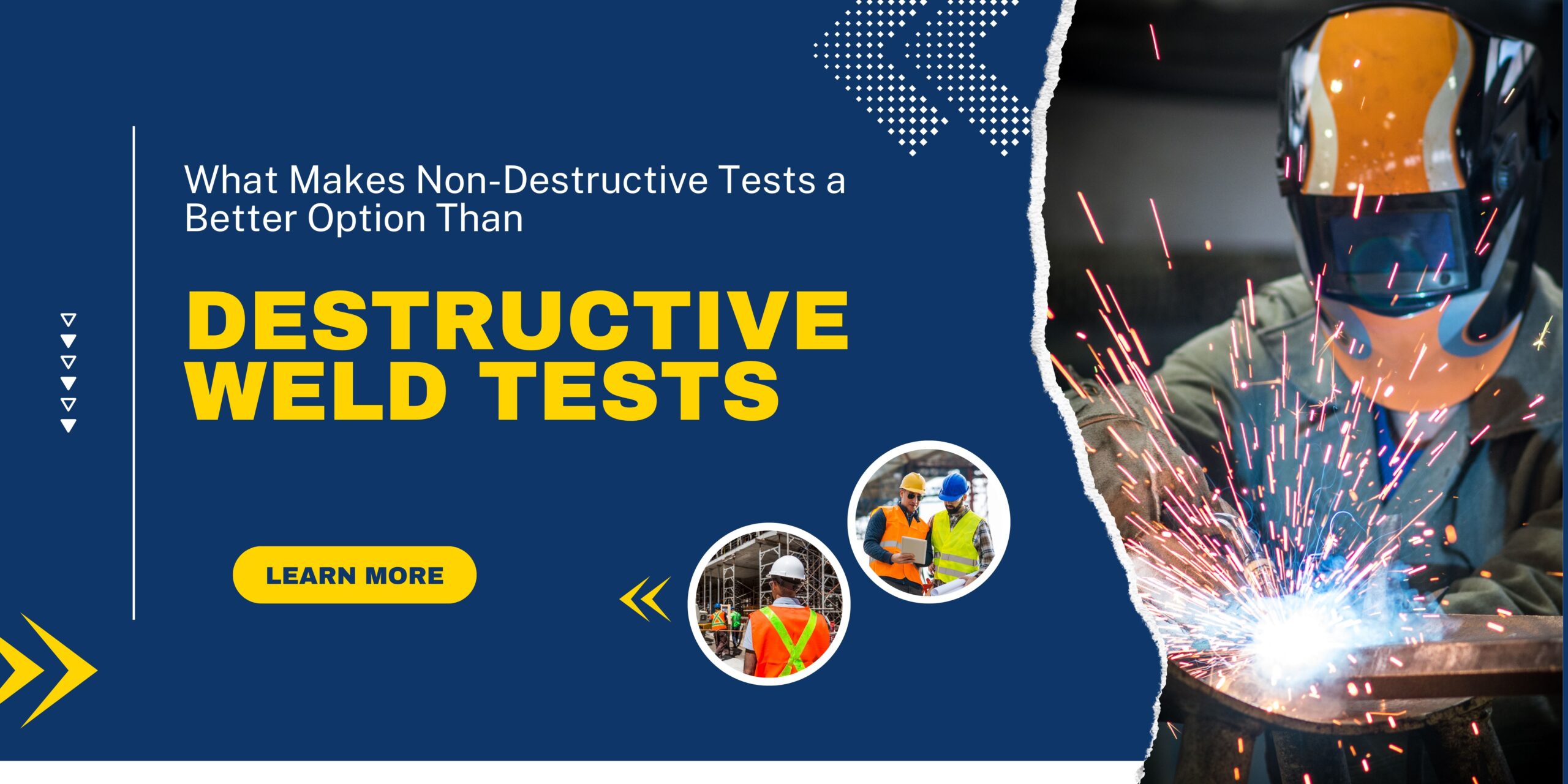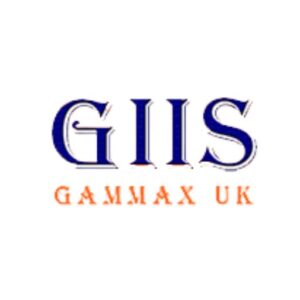
What Makes Non-Destructive Tests a Better Option Than Destructive Weld Tests?
In the complex world of weld inspection, the decision between destructive and non-destructive testing (NDT) methods plays a pivotal role in determining the success and sustainability of a project. In this comprehensive guide, we will delve into the definition of both kinds of weld testing, their types, applications and numerous reasons why non-destructive weld testing stands out as the superior choice over destructive weld tests.
Destructive Weld Test: Definition
Destructive weld testing is a quality assurance method for welding projects. Here a welded sample is destroyed to check its strength and overall condition. To carry out this process, an area of the weld is separated out and then tested in different ways— such as tensile, bend, and fracture tests—to measure characteristics such as strength, ductility and the weld’s soundness. They reveal potential weaknesses, check that the weld matches the requirements and assess the welding procedures or welder qualifications. Common destructive testing methods include macro etch testing, bend or tensile tests. Macro etch testing uses acids to uncover the weld’s structure, while bend or tensile tests examine its ability to deal with bending and stretching. Since the sample is destroyed after testing, this kind of testing is mostly reserved for procedure and performance qualifications.
Types of Destructive Weld Tests
The main types of destructive weld tests include:
Tensile Test: The test measures the maximum force a welded joint can resist when it is pulled apart, and determines its tensile strength and ductility.
Bend Test: In bend test the sample is bent to a specified angle and checked for cracks or defects. It reveals the ductility and integrity of the sample.
Macro Etch Test: In micro etching, a cross section of a weld is cut and polished, then exposed to an acid etch to reveal its internal structure. It detects issues within the weld such as – incomplete fusion or porosity.
Fillet Weld Break Test: In a fillet weld break test, a weld is fractured, and the exposed surface is examined for internal flaws such as slag inclusions or lack of fusion.
Charpy Impact Test: This test evaluates a weld’s toughness by measuring the energy absorbed when a notched sample is broken under impact.
Nick Break Test: In this test the sample is notched and broken to expose the weld’s interior, which reveals hidden defects.
Applications
Key applications of destructive weld testing include:
Welding Procedure Qualification: It verifies that a specific welding procedure produces joints meeting required standards for strength and integrity.
Welder Performance Qualification: It is used to assess the skill and capability of welders or welding operators to produce sound welds under specified conditions.
Quality Control: It is used during manufacturing to ensure that welds in products like pressure vessels, pipelines, valves, and structural components meet safety and performance criteria.
Failure Investigation: Destructive testing helps identify the causes of weld failures, allowing for improvements in materials, procedures, or design.
Materials Characterisation: It also provides detailed information about the mechanical properties and internal structure of welds, supporting research and development.
Industry Compliance: Sectors such as aerospace, automotive, construction, oil and gas, and power generation use destructive weld testing to meet stringent industry standards and regulatory requirements.
Non Destructive Weld Test: Definition
Non-destructive weld testing (NDT) is a group of inspection techniques used to evaluate the quality and integrity of welds without causing any damage to the welded component. These methods allow for the detection of surface and internal defects, such as cracks, porosity, or lack of fusion, and ensure that the weld meets required safety and performance standards while preserving the sample for use. Common NDT methods include visual inspection, liquid penetrant testing, magnetic particle inspection, ultrasonic testing, radiography, and eddy current testing. NDT is widely used in industries like construction, aerospace, and manufacturing, where it is essential to verify weld quality without compromising the component’s structural integrity. Through NDT, manufacturers can ensure product reliability, reduce costs associated with failures, and comply with industry regulations.
Types of Non-destructive Weld Testing
These are the different non-destructive weld testing (NDT) methods, each designed to detect different types of defects in welds without damaging the component:
Visual Inspection (VT): This is the simplest and most widely used NDT method, which involves a direct visual check for surface flaws, cracks, or misalignments.
Liquid Penetrant Testing (PT): In this kind of non-destructive testing a dye or fluorescent liquid is applied to the weld surface, which reveals surface-breaking defects when viewed under appropriate lighting.
Magnetic Particle Testing (MT): This method applies magnetic particles to the weld area to detect surface and near-surface discontinuities. It can only be used to test ferromagnetic materials.
Ultrasonic Testing (UT): In ultrasonic testing, high-frequency sound waves are sent through the weld and the reflected signals are analysed to detect internal flaws, such as cracks or voids.
Radiographic Testing (RT): Radiographic testing uses x-rays or gamma rays to create images of the weld’s internal structure and reveal hidden defects like porosity or inclusions.
Eddy Current Testing (ET): This electromagnetic technique is effective for detecting surface and near-surface flaws, especially in conductive materials.
Thermal/Infrared Testing: Infrared testing uses thermal imaging to identify subsurface defects by detecting irregular heat flow patterns.
Acoustic Emission Testing: This method monitors sound waves produced by the rapid release of energy from localised sources within the weld to detect defects.
Leak Testing: Leak testing checks for leaks in welded containers or vessels by applying pressure and observing for fluid escape.
Applications
NDT has various applications across different industries, some of which are mentioned below:
Quality Assessment: It is used for quality assessment of manufactured parts to ensure they meet specifications and standards.
Weld Inspection: It inspects welds in pipelines, pressure vessels, storage tanks, and critical structures for cracks, porosity, and other defects.
Civil Engineering: It is applied in civil engineering to inspect bridges, buildings, structural foundations, and even cultural heritage monuments.
Routine Inspections: NDT is also used during routine and special inspections of equipment and structures without causing damage, even in hard-to-reach areas.
Oil & Gas Industry: It is used in the oil and gas industry for corrosion assessment, weld quality assurance, and detection of cracks in pipelines and pressure vessels.
Quality Control: NDT is essential in manufacturing, automotive, aerospace, maritime, power generation, and defense industries for quality control and maintenance.
Fault Detection: It helps to detect corrosion, erosion, and cracks in heat exchanger tubes, turbine blades, and other critical components.
Compliance Assurance: It helps to ensure compliance with safety regulations and extends the service life of assets by enabling early defect detection.
Factors That Make Non-Destructive Weld Tests a Superior Choice:
The Wider Reach of NDT
Destructive weld tests, though direct, often fall short when it comes to providing the extensive reach required for thorough weld inspections. For large infrastructures, destructive testing necessitates the destruction of weld components to uncover hidden flaws. This approach not only increases the risk of missing indications on expansive designs but also compromises the structural integrity of the weld and raises concerns about safety in the long run. For instance, consider an oil pipeline inspection scenario using long-range ultrasonic testing as part of the NDT approach. The weld analyst can detect corrosive anomalies over 50 feet away without compromising any structural points of the pipeline. This level of precision and non-intrusiveness is unattainable with destructive testing, which mandates direct interaction and potential damage to the object being inspected.
Application in Various Industries
NDT offers a flexible and non-destructive way to weld inspection. This makes it an ideal choice for various industries. Destructive weld tests can be dangerous in certain testing environments like oil rigs, nuclear power plants, and railroad tracks. In such cases, NDT techniques offer a comprehensive and safe solution for weld inspectors. Particularly for nuclear plants, the long reach of NDT methods, like ultrasonic testing, keeps the personnel safe by keeping them away from radioactive zones. Advanced NDT techniques, such as eddy current testing (ECT), improve the efficiency of weld inspection. This is because they allow to inspect materials without compromising structural integrity. They not only help to detect surface flaws but also excellent for finding sub-surface abnormalities, like faults behind walls or protective coatings. This means they not only make the testing process safer by minimising direct interaction with potentially dangerous elements but also offer high accuracy.
Time-Saving with NDT
Beyond its wider reach, one of the standout advantages of the non-destructive weld test is its time-saving potential. Companies that have to deal with vast inventories of products or equipment cannot afford the tedious task of breaking down materials for testing purposes, as required in destructive testing. NDT doesn’t need such disruptive and time consuming processes, and offers a seamless alternative. Portable NDT instruments further contribute to enhanced efficiency and allow weld inspectors to probe nearly every part of an object with minimal interruption. Certain advanced NDT methods can even provide instant data with a single pass of the instrument. This kind of flexibility and speed is simply impossible to achieve with destructive testing. Companies can use the overall time and labour hours saved with NDT to increase productivity and improve other aspects of their business.
Cost-Saving with NDT Techniques
When choosing between non-destructive and destructive weld tests, the cost effective nature of NDT techniques emerges as a compelling factor. Innovative methods, such as eddy current technology and ultrasonic technology, use sensitive signals that can detect more aberrations in less time without causing any damage to the original structure, unlike destructive testing. While destructive testing may provide reliable results, its manual processes and material degradation procedures come at a significant cost. Moreover, NDT’s automated procedures, coupled with the latest software interfaces, allow weld inspectors to quickly and accurately detect aberrations that could lead to costly damage in the future. This high precision and cost saving nature of NDT techniques make them the preferred method for weld inspection across various industries without compromising the safety or integrity of the welds.
Conclusion
Non-destructive weld tests emerge as the unrivalled choice for weld inspection due to their efficiency, cost-effectiveness, and precision. The wider reach, diverse applications, time-saving factor, and reliability of NDT techniques position them as the go-to method for ensuring the integrity of welds without compromising safety or incurring unnecessary expenses. As advanced and accurate welding inspection techniques become the need of the hour, embracing non-destructive testing becomes a necessity for ensuring structural integrity in various industries. The benefits of NDT go beyond what it offers; they are about what it preserves—the safety and integrity of what is being inspected.
Gammax: The Best Non-Destructive Weld Testing Provider in the UK
At Gammax Independent Inspection Services Ltd, we specialise in non-destructive weld testing. With a stellar track record since 1995, we cater to diverse industries, from oil and gas to Formula One. Our swift 24-hour response, adherence to industry codes, and UKAS accreditation ensure top-notch services. Trust us for precision and reliability in welding inspection. Contact us today.

Gammax Team
Here at Gammax Independed Inspection Services, our editorial team consists of BS EN ISO 9712 certified welding experts and consultants. We are committed to offer you latest industry news and up to date information regarding various non destructive inspection procedures.
